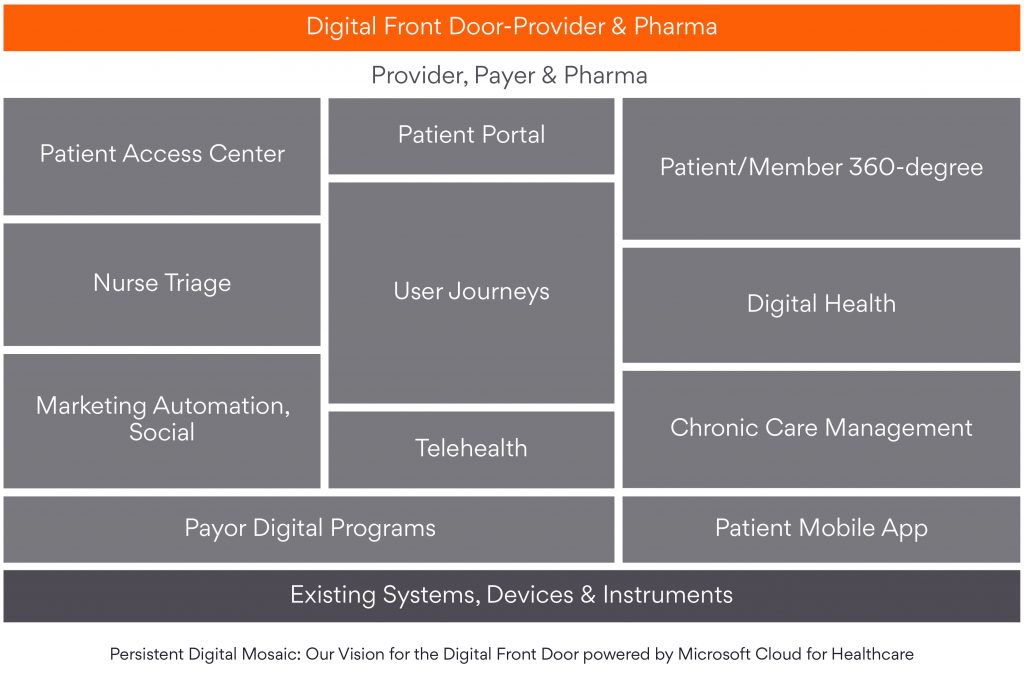Microsoft announced its Cloud for Healthcare will be generally available on Oct. 30. It will provide managed services to support healthcare organizations and can store health data in the cloud. With this new service, the company aims to improve data interoperability, workflow efficiency as well as streamline interactions. It will also provide new capabilities for patients to engage with their providers. Persistent is a partner of Micrsosoft for the health cloud and related services and has a host of solutions built leveraging it.
Let’s take a sneak peek at their new healthcare strategy, how it will work with Persistent’s Digital Front Door offering, and then look at the impact this new health cloud from Microsoft will have on overall patient experience, engagement, acquisition, and retention as well as providers
Microsoft’s HealthCare Strategy
When a provider thinks moving to cloud, Microsoft should be their no.1 choice
Microsoft is following a “blueprint” to bring more health data to the cloud and has launched a number of products and services. CFO Amy Hood noted that “In FY 2019, [MS] closed a record number of multi-million dollar commercial cloud agreements with a material growth in the number of $10 million-plus Azure agreements.”
To be seen providers’ partner not a competitive threat
Providence CEO Rod Hochman said in announcing the deal, he chose Microsoft over Google, Apple, and Amazon because it’s not “trying to do health care”. He added, “[Microsoft isn’t] trying to be in the healthcare business, but [is] trying to make it better.”
To use AI to make health care better
Microsoft’s aspirations in the emerging field of AI are high. Some instances are deal with UCLA, to store its vast health data which will be then used to accelerate precision medicine research and improve patient care. Another major project with Novartis is Data42, which will mine two million patient-years of clinical data to try to meet goals such as shorten the time to market for new medicines by 2 years, create more-personalized customer experiences with the aim of reaching twice as many patients twice as fast; and increase R&D investments by cutting operational costs by at least $1 billion and perhaps as much as $2 billion. The company is working with Nuance Communications, a software company, to revamp hospital exam rooms with AI and NLP. The collaboration brings together Microsoft’s Azure cloud platform and AI capabilities with Nuance’s expertise with clinical documentation and clinical speech recognition to develop ambient clinical intelligence (ACI). Here the major pain point of too much time spent on documenting and administrative tasks by doctors is being targeted. The aim is to create an exam room experience where the clinical documentation “writes itself”.
The technology is designed to “listen” to physician-patient conversations, with the patient’s consent, during a doctor’s visit. ACI then synthesizes the conversation, integrates the data with contextual information from the EHR, and updates the patient’s medical record. The technology also provides workflow, task, and knowledge automation
To help health care professionals talk to each other and their patients
One of Microsoft’s major offerings is its Teams platform. Emma Williams, corporate VP of modern workplace verticals at Microsoft said, “more than 500,000 organizations, including 91 of the Fortune 100 and many of the most innovative health care providers, are empowering their employees with MS 365 and Teams.”
Microsoft touts providers such as St. Luke’s University Health Network for illustrating how health care organizations can use Teams. As envisioned by St. Luke’s CIO Chad Brisendine, “Clinicians will carry a smartphone loaded with the mobile app to accelerate communication … quickly in a ‘digital huddle,’ [which] will expedite their decisions on treatment protocols, improving health outcomes for patients.”
Thus, the above-mentioned points neatly outline the benefits that will be accumulated by providers. The subsequent sections will talk about the Persistent Digital Front Door offering based on Microsoft health cloud service and then point to how patients are in for a superior, seamless experience when it comes to this offering.
Persistent’s Digital Front Door on Microsoft Health Cloud
Enter Persistent’s Digital Front Door. This platform has all it takes to fundamentally disrupt the way patients and healthcare ecosystem players like providers will interact. Think what Amazon did to shopping or iTunes did to music. While no real consensus exists about what a DFD entails in healthcare, some consensus has emerged that It goes well beyond merely enabling a patient portal or deploying a mobile app, or doing telehealth.
With the force of Microsoft Dynamic 365, Azure, Power platform, 365 and Teams the following provider processes but not just limited to them, can be efficiently enabled by Persistent’s Digital Front Door:
- Patient experience and access to care
- Patient engagement and contact center
- Care management and coordination
- Patient and consumer outreach and marketing
- Virtual visits and consults
- Healthcare interoperability, IoT, and patient monitoring
Microsoft + DFD = Engaged Patients + Productive Providers
Personalize the patient experience: The move towards consumerization is already disrupting the industry. However, both the patient and providers are still working out the final shape.
“We have to design around how we make someone feel, not what we want,” Tim Pantello, MD at PwC US, said at HIMSS19.
Microsoft already seems to be making inroads in this space. Using Dynamic 365, Providence St. Joseph Health2 moved beyond the typical call center to provide more personalized experiences for every patient, better-addressing patient needs, and helping patients access the right care with the right providers
A digital experience that renders a seamless feel: Cincinnati Children’s3 makes tough times easier with a family-friendly mobile app. Built on Azure and its cognitive services language understanding, Cincinnati used its rich experience with the web, social and inputs from its online patient community, to design an app that’s loaded with features such as: Way finder, look up locations, see wait times at urgent care centers, real-time updates of a child’s surgery status, a digital parking pass, store parking location for later ref. There’s also a natural language chatbot for answers, along with jokes and a scavenger hunt throughout the hospital.
More than what it seems: It’s not just about getting the above-mentioned product bundles. A provider who leverages these will benefit in many other ways. Northwell Health4 has speeded up the development and adoption of innovative apps that improve patient care using Microsoft Teams as a platform. Using Azure components and a suite of other platforms, they have simplified access to patient information with a clinician chatbot. Have used the Azure cloud platform to quickly build in-house apps and are managing care plans to reduce hospital stays.
Invest today, reap forever: Helsinki and Uusimaa Hospital District (HUS)5 used Microsoft cloud solutions to create a Virtual Hospital, which provides digital health services that improve patient access to quality care, reduce costs, and enable healthcare providers to treat more patients in less time. According to Honkanen, Director of Strategic Development the solution is providing remarkable cost savings.
Honkanen, Director of Strategic Development said, “We have calculated that if we can use virtual therapies to decrease outpatient visits by only 5 percent, which is a very conservative estimate, we will pay for these digital services five times over in just three years.”
Though the above are just one instance for each type of benefit, they are representative of the numerous ways in which a provider will not only benefit in cost savings but also will be able to differentiate themselves to engage in a superior way with the patients if they decide to go with Microsoft’s services to realize their DFD.
Learn more about how we at Persistent have envisioned the DFD to help providers achieve their goals and connect better with their patients
References:
- The Forrester Wave™: Enterprise Health Clouds, Q3 2019 Report
- Providence St. Joseph Health provides a personalized patient experience with Microsoft Dynamics 365
- Cincinnati Children’s makes tough times easier with family-friendly mobile app
- Northwell Health speeds development and adoption of innovative apps that improve patient care using Microsoft Teams as a platform
- Virtual Hospital improves patients’ healthcare access, dramatically cuts costs
Find more content about
Health Cloud (1) Microsoft Health Cloud (1) Cloud For Healthcare (1) Microsoft Partner (1) Digital Front Door (2)




